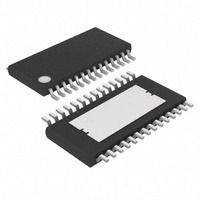MAX7456EUI+T Maxim Integrated Products, MAX7456EUI+T Datasheet - Page 39

MAX7456EUI+T
Manufacturer Part Number
MAX7456EUI+T
Description
IC DISPLAY 1CH W/EEPROM 28TSSOP
Manufacturer
Maxim Integrated Products
Type
OSD (On-Screen Display) Video Generatorr
Datasheet
1.MAX7456EUI.pdf
(44 pages)
Specifications of MAX7456EUI+T
Applications
Security Systems, Video Routing
Mounting Type
Surface Mount
Package / Case
28-TSSOP Exposed Pad, 28-eTSSOP, 28-HTSSOP
Current - Supply
58mA
Voltage - Supply
4.75 V ~ 5.25 V
Operating Temperature
-40°C ~ 85°C
Interface
SPI Serial
Display Type
OSD
Digits Or Characters
256 Characters
Lead Free Status / RoHS Status
Lead free / RoHS Compliant
Configuration
-
Lead Free Status / Rohs Status
Details
Writing the Character Address Byte to the Display
Memory:
1) Write DMAH[1] = 0 to write a Character Address
2) Write DMAH[0] = x to select the MSB and
3) Write the Character Address byte (CA[7:0]) to be
Writing the Character Attribute Byte to the Display
Memory:
1) Write DMAH[1] = 1 to write a Character Attribute
2) Write DMAH[0] = x to select the MSB and
3) Write the Character Attribute byte to be written to
The 16-bit operation mode increases the speed at
which the display memory can be updated. This is
done by automatically copying DMM[5:3] to a
Character’s Attribute byte when a new character is writ-
ten, thus reducing the number of SPI write operations
per character from two to one (Figure 19). When in this
mode, all characters written to the display memory
have the same attribute byte. This mode is useful
because successive characters commonly have the
same attribute. This mode is distinct from the 8-bit
operation mode where a Character Attribute byte must
be written each time a Character Address byte is writ-
ten to the display memory (see Table 5).
1) Write DMM[6] = 0 to select the 16-bit operation
2) Write DMM[5:3] = xxx to set the Local Background
3) Write DMAH[0] = x to select the MSB and
byte.
DMAL[7:0] = xxH to select the lower order bits of
the address where the character data is to be writ-
ten. This address determines the location of the
character on the display (see Figure 10).
written to the display memory to DMDI[7:0] (see
Figures 10, 12, and 19).
byte.
DMAL[7:0] = xxH to select the lower order bits of
the address where the character data is to be writ-
ten. This address determines the location of the
character on the display (Figure 10).
the display memory to DMDI[7:0] (see Figures 10
and 19).
mode.
Control (LBC), Blink (BLK), and Invert (INV) attribute
bits that will be applied to all characters written to
the display memory while in the 16-bit operation
mode.
DMAL[7:0] = xxH to select the lower order bits of the
address where the character data is to be written.
______________________________________________________________________________________
Display Memory in 16-Bit Mode
Single-Channel Monochrome On-Screen
Steps for Writing to
Display with Integrated EEPROM
4) Write the Character Address byte (CA[7:0]) to be
Auto-increment mode increases the speed at which the
display memory can be written by automatically incre-
menting the character address for each successive
character written. This mode is useful when writing
strings of characters written from left-to-right and top-
to-bottom on the display. This mode reduces the num-
ber of SPI commands (see Table 5).
When in 8-Bit Operating Mode:
1) Write DMAH[1] = 0 to select if the Character
2) Write DMAH[0] = X to select the MSB and DMAL[7:0]
3) Write DMM[0] = 1 to set the auto-increment mode.
4) Write DMM[6] = 1 to set the 8-bit operating mode.
5) Write CA data in the intended character order to dis-
6) Write CA = FFh to terminate the auto-increment
Note: The character stored at CA[7:0] = FFh is not avail-
able for use in auto-increment mode. Read operation is
not possible before auto-increment mode is terminated.
When in 16-Bit Operating Mode:
1) Write DMAH[0] = X to select the MSB and
2) Write DMM[0] = 1 to set the auto-increment mode.
3) Write DMM[6] = 0 to set the 16-bit operating mode.
Address byte will be written or DMAH[1] = 1 to
select if the Character Attribute byte will be written.
= XX to select the lower order address bits of the
starting address for auto-increment operation. This
address determines the location of the first character
on the display (see Figures 10 and 21).
play text on the screen. This is the single byte oper-
ation. The DMDI[7:0] address is automatically set by
auto-increment mode. The display memory address
is automatically incremented following the write
operation until the final display memory address is
reached.
mode.
DMAL[7:0] = XX to select the lower order address
bits of the starting address for auto-increment oper-
ation. This address determines the location of the
first character on the display (see Figures 10 and
21).
This address determines the location of the charac-
ter on the display (see Figure 10).
written to the display memory into DMDI[7:0]. It will
be stored along with a Character Attribute byte
derived from DMM[5:3] (Figures 12 and 19).
Steps for Writing to Display Memory
in Auto-Increment Mode
39











